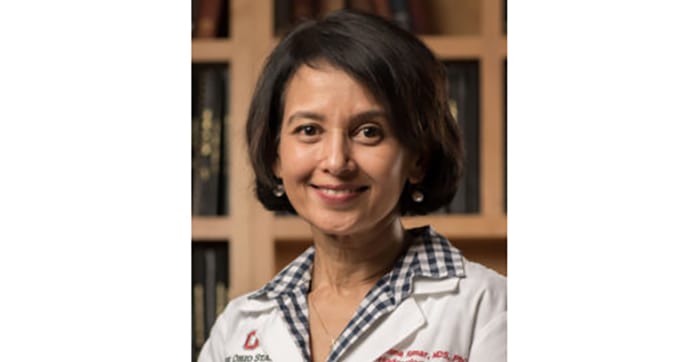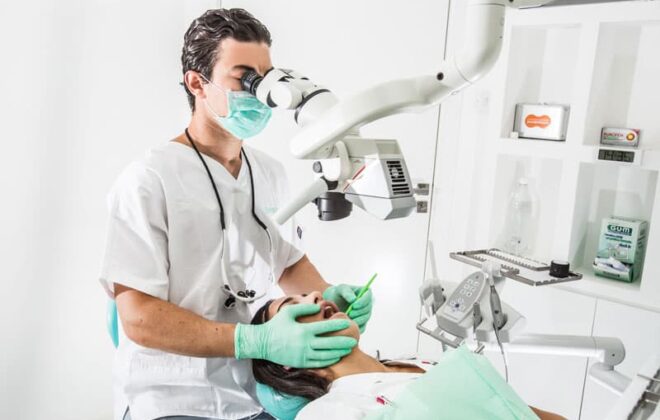Aerosols and Coronavirus in Dentistry
As a part of its ongoing featured expert series, the AAE recently interviewed Dr. Purnima Kumar about aerosols in dentistry during COVID-19. Dr. Pumar is a professor of periodontology at The Ohio State University. She received her dental degree from Annamalai University in India, and her master’s in periodontology and Ph.D. in molecular microbiology from The Ohio State University. She is a Diplomate of the American Board of Periodontology.
In addition to her clinical practice, Dr. Kumar maintains an active research laboratory that is funded through the NIH and oral healthcare industry collaborations. She serves as an editor for numerous journals including the Journal of Periodontology and Microbiome. She has several publications in peer-reviewed scientific journals and has written book-chapters in molecular microbiology and periodontology. She has also been invited to lecture at several national and international meetings on the microbial etiology of periodontitis. She presently serves as the chair of the Continuing Education Oversight Committee for the American Academy of Periodontology and on the Council for Scientific Affairs of the American Dental Association and the Taskforce for Women in Periodontics. She is also the official spokesperson for the ADA on e-cigarettes and vaping.
To what extent does the use of rubber dam with non-surgical endodontic treatment result in a lesser-aerosol exposure or safer procedure?
It is difficult to quantify the reduction in aerosol as a percentage, but there is evidence from several studies that use of rubber dam reduces the amount of aerosol generated, as well as, the microbial bioload in aerosols. The use of rubber dam has also been advocated by endodontists practicing at the height of the COVID crisis in Wuhan as a measure to reduce cross-contamination.
How do endodontists minimize aerosol exposure, given the increased aerosol generation of endo procedures?
Reducing aerosols at source is the best way; followed by mitigating aerosols dispersion and protecting the person from aerosol microbiota. Reducing microbial payload in aerosols at source can be achieved by using high volume evacuators, isolating the tooth or area, pre-procedural mouthwashes and reducing procedure time. HVEs can be intra-oral or extra-oral. While there is substantial evidence supporting intra-oral HVEs as an effective method to reduce aerosol generation, similar evidence is lacking for extra-oral HVEs. Rubber dam is another method to ensure that salivary microbiota is not transmitted in the aerosols. Pre-procedural mouthwashes have been shown to substantially reduce microbial load in aerosols, as has reduced procedure time. The studies from Wuhan and Italy at the height of COVID crisis have reported limiting procedures times to 15 minutes. Aerosol contamination can be mitigated by efficient air flow engineering, surface disinfection, and air filtration devices. There is a lot of evidence to support chemical surface disinfection, but similar evidence for UV light and other non-chemical germicides is not available for dental aerosols. Personal protective equipment are the last line of defense against aerosol exposure. However, these when used correctly, offer a significant level of protection from diseases caused by airborne or blood-borne pathogens.
How much exposure is too much exposure?
There is no magic number that can determine exposure. It depends on many factors. As a rule of thumb, infection = dose multiplied by exposure. This is modified by the immune status, nature of the infective agent, route of transmission etc.
What is the right PPE with regard to aerosol generation? How does an L3 taped with a mask over it compare to an N95?
The evidence is equivocal regarding the efficacy of N95 versus a Level 3 surgical mask with respect to filtration ability. The N95 offers the additional advantage of a better fit than does the Level 3 surgical mask.
What can we do if we don’t have N95s or similar FFRs?
Personal protection is an important aspect of safe re-opening. It is important to follow the guidelines set forth by the ADA, CDC and your state.
What should an endodontist do if concerned that there has already been a high level of aerosol exposure, but is asymptomatic?
Many states advise that in case of COVID exposure, or if the patient who has been treated in the office reports COVID positive within 14 days of treatment, the Department of Health or a similar regulatory authority be immediately contacted. These authorities will offer directives on contact tracing and other steps.
When is a negative pressure room or AIIR recommended, and what do we do if we can’t access one?
Negative pressure rooms are designed to keep the infective agent inside the operatory and prevent its spread to others in the hallway or other areas. They do not protect the patient or the healthcare worker in the operatory.
When dental practices open, what do you predict the new guidelines for infection control may entail?
It is hoped that as we gain more insight into the spread of disease, and dental office patient contact information is incorporated into models of disease contagion, we will be able to make more informed decisions regarding infection control specific to dental aerosols, and not rely so heavily on medical aerosol data.
Do you think endodontists need to consider investing in systems for HVAC, including plasma, UV light and HEPA Filters?
Dentistry is rarely aerosol-free, and all of these systems can provide additional means of mitigating contagion spread, however, rigorous studies on efficacy in dental settings are not as yet available.
What can endodontists do to protect their eyes when using microscopes?
I am assuming that endodontists already use some means to protect their eyes when using microscopes, because dental aerosols have been present even before COVID brought this issue to the forefront.
Do you think we will be required to install equipment to manage aerosols in general in the future? If so, what kind?
There are no requirements right now, only guidelines. Only well-controlled studies can inform such decisions.
To enhance capture of patient exhaled aerosols, has the delivery of supplemental oxygen via a nasal cup with scavenger suction been studied or advocated?
Not to my knowledge. How does one clean those lines of the suction, especially when considering a respiratory disease that spreads from naso-pharyngeal and oro-pharyngeal secretions? Use disposable cups and tubing?
Originally posted at: https://www.aae.org/specialty/2020/06/02/aerosols-and-coronavirus-in-dentistry/
Author: Purnima Kumar DDS, PhD Professor College of Dentistry The Ohio State University



